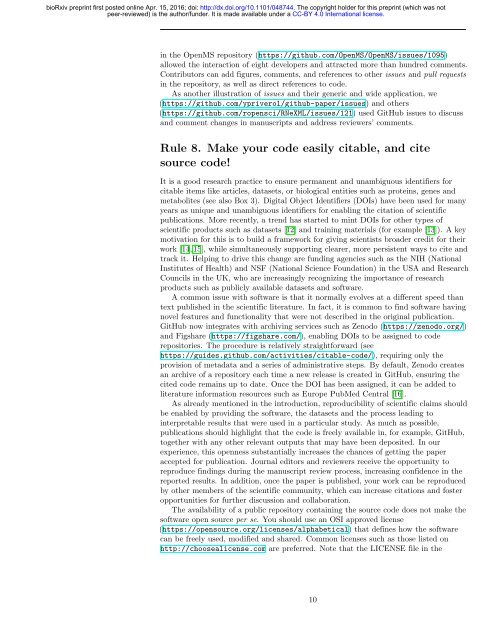Ten Simple Rules for Taking Advantage of git and GitHub Abstract
048744.full
048744.full
Create successful ePaper yourself
Turn your PDF publications into a flip-book with our unique Google optimized e-Paper software.
ioRxiv preprint first posted online Apr. 15, 2016; doi: http://dx.doi.org/10.1101/048744. The copyright holder <strong>for</strong> this preprint (which was not<br />
peer-reviewed) is the author/funder. It is made available under a CC-BY 4.0 International license.<br />
in the OpenMS repository (https://<strong>git</strong>hub.com/OpenMS/OpenMS/issues/1095)<br />
allowed the interaction <strong>of</strong> eight developers <strong>and</strong> attracted more than hundred comments.<br />
Contributors can add figures, comments, <strong>and</strong> references to other issues <strong>and</strong> pull requests<br />
in the repository, as well as direct references to code.<br />
As another illustration <strong>of</strong> issues <strong>and</strong> their generic <strong>and</strong> wide application, we<br />
(https://<strong>git</strong>hub.com/ypriverol/<strong>git</strong>hub-paper/issues) <strong>and</strong> others<br />
(https://<strong>git</strong>hub.com/ropensci/RNeXML/issues/121) used <strong>GitHub</strong> issues to discuss<br />
<strong>and</strong> comment changes in manuscripts <strong>and</strong> address reviewers’ comments.<br />
Rule 8. Make your code easily citable, <strong>and</strong> cite<br />
source code!<br />
It is a good research practice to ensure permanent <strong>and</strong> unambiguous identifiers <strong>for</strong><br />
citable items like articles, datasets, or biological entities such as proteins, genes <strong>and</strong><br />
metabolites (see also Box 3). Di<strong>git</strong>al Object Identifiers (DOIs) have been used <strong>for</strong> many<br />
years as unique <strong>and</strong> unambiguous identifiers <strong>for</strong> enabling the citation <strong>of</strong> scientific<br />
publications. More recently, a trend has started to mint DOIs <strong>for</strong> other types <strong>of</strong><br />
scientific products such as datasets [12] <strong>and</strong> training materials (<strong>for</strong> example [13]). A key<br />
motivation <strong>for</strong> this is to build a framework <strong>for</strong> giving scientists broader credit <strong>for</strong> their<br />
work [14, 15], while simultaneously supporting clearer, more persistent ways to cite <strong>and</strong><br />
track it. Helping to drive this change are funding agencies such as the NIH (National<br />
Institutes <strong>of</strong> Health) <strong>and</strong> NSF (National Science Foundation) in the USA <strong>and</strong> Research<br />
Councils in the UK, who are increasingly recognizing the importance <strong>of</strong> research<br />
products such as publicly available datasets <strong>and</strong> s<strong>of</strong>tware.<br />
A common issue with s<strong>of</strong>tware is that it normally evolves at a different speed than<br />
text published in the scientific literature. In fact, it is common to find s<strong>of</strong>tware having<br />
novel features <strong>and</strong> functionality that were not described in the original publication.<br />
<strong>GitHub</strong> now integrates with archiving services such as Zenodo (https://zenodo.org/)<br />
<strong>and</strong> Figshare (https://figshare.com/), enabling DOIs to be assigned to code<br />
repositories. The procedure is relatively straight<strong>for</strong>ward (see<br />
https://guides.<strong>git</strong>hub.com/activities/citable-code/), requiring only the<br />
provision <strong>of</strong> metadata <strong>and</strong> a series <strong>of</strong> administrative steps. By default, Zenodo creates<br />
an archive <strong>of</strong> a repository each time a new release is created in <strong>GitHub</strong>, ensuring the<br />
cited code remains up to date. Once the DOI has been assigned, it can be added to<br />
literature in<strong>for</strong>mation resources such as Europe PubMed Central [16].<br />
As already mentioned in the introduction, reproducibility <strong>of</strong> scientific claims should<br />
be enabled by providing the s<strong>of</strong>tware, the datasets <strong>and</strong> the process leading to<br />
interpretable results that were used in a particular study. As much as possible,<br />
publications should highlight that the code is freely available in, <strong>for</strong> example, <strong>GitHub</strong>,<br />
together with any other relevant outputs that may have been deposited. In our<br />
experience, this openness substantially increases the chances <strong>of</strong> getting the paper<br />
accepted <strong>for</strong> publication. Journal editors <strong>and</strong> reviewers receive the opportunity to<br />
reproduce findings during the manuscript review process, increasing confidence in the<br />
reported results. In addition, once the paper is published, your work can be reproduced<br />
by other members <strong>of</strong> the scientific community, which can increase citations <strong>and</strong> foster<br />
opportunities <strong>for</strong> further discussion <strong>and</strong> collaboration.<br />
The availability <strong>of</strong> a public repository containing the source code does not make the<br />
s<strong>of</strong>tware open source per se. You should use an OSI approved license<br />
(https://opensource.org/licenses/alphabetical) that defines how the s<strong>of</strong>tware<br />
can be freely used, modified <strong>and</strong> shared. Common licenses such as those listed on<br />
http://choosealicense.com are preferred. Note that the LICENSE file in the<br />
10



